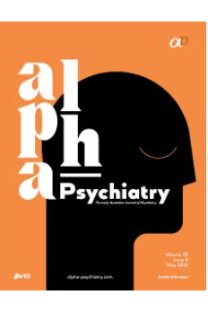DSM-5 Düzey 1 Kesitsel Belirti Ölçeği Türkçe Formunun geçerliliği ve güvenilirliği (11-17 Yaş Çocuk ve 6-17 Yaş Anne-Baba Formları)
Validity and reliability of DSM-5 Level 1 Cross-Cutting Symptom Scale Turkish Version (Child Form for 11-17 Years and Parent Form for 6-17 Years)
___
1. Costello EJ, Egger H, Angold A. 10-Year research update review: the epidemiology of child and adolescent psychiatric disorders: I. methods and public health burden. J Am Acad Child Adolesc Psychiatry 2005; 44:972-986.2. Merikangas KR, Nakamura EF, Kessler RC. Epidemiology of mental disorders in children and adolescents. Dialogues Clin Neurosci 2009; 11:7- 20.
3. Kessler RC, Angermeyer M, Anthony JC, Graaf R, Demyttenaere K, Gasquet I, et al. Lifetime prevalence and age of onset distributions of mental disorders in the World Health Organization's World Mental Health Survey Initiative. World Psychiatry 2007; 6:168-176.
4. Patel V, Flischer AJ, Hetrick S, McGorry P. Mental health of young people: a global public health challenge. Lancet 2007; 369:1302-1313.
5. Leaf PJ, Alegria M, Cohen P, Goodman SH, Horwitz SM, Hoven CW, et al. Mental health service use in the community and schools: results from the four-community MECA study. J Am Acad Child Adolesc Psychiatry 1996; 35:889-897.
6. Verhulst F, Ende JV. Rating Scales. M Rutter, E Taylor (Eds.), Child and Adolescent Psychiatry, fourth ed., Massachusetts: Blackwell Science, 2002, p.70.
7. Erol N, Arslan LB, Akçakın M. The adaptation and standardization of the Child Behavior Checklist among 6-18 year old Turkish children. J Sergeant (Ed.), Eunethydis, European Approaches to Hiperkinetic Disorders. Zurich: Fotorotor, Egg, 1995, p.109-113.
8. Yalın Ş, Özbek A, Güvenir T, Baydur H. The Advanced Psychometric Properties of Turkish Strengths and Difficulties Questionnaire (SDQ). Turk J Child Adolesc Ment Health 2013; 20:23-32.
9. Amerikan Psikiyatri Birliği. Ruhsal Bozuklukların Tanısal ve Sayımsal Elkitabı. Beşinci baskı, E Köroğlu (Çev. Ed.), Ankara: Hekimler Yayın Birliği, 2013.
10. http://www.psychiatry.org/practice/dsm/ dsm5/online-assessment-measures
11. Narrow WE, Clarke DE, Kuramoto SJ, Kraemer HC, Kupfer DJ, Greiner L, et al. DSM-5 Field Trials in the United States and Canada, Part III: Development and Reliability Testing of Cross-Cutting Symptom Assessment for DSM-5. Am J Psychiatry 2013; 170:71-82.
12. Tavşancıl E. Tutumların Ölçülmesi ve SPSS ile Veri Analizi. Ankara: Nobel Yayın Dağıtım, 2006.
13. Baydur H, Eser E. Uygulama: Yaşam kalitesi ölçeklerinin psikometrik çözümlenmesi. Sağlıkta Birikim 2006; 1:99-123.
14. Köroğlu E, Aydemir Ö, Türkçapar H. Psikiyatride Araştırma Tasarımı, Yönetimi ve Denetimi. Ankara: HYB, 2012.
15. Akdemir D, Ünal F. Ergenlerde anksiyete bozuklukları ve sağaltımı. Turkiye Klinikleri 2010; 3:39- 47.
16. Pavuluri MN, Herbener ES, Seweeney JA. Psychotic symptoms in pediatric bipolar disorder. J Affect Disord 2004; 80:19-28.
17. Haan L, Sterk B, Wouters L, Linszen DH. The 5- year course of obsessive-compulsive symptoms and obsessive-compulsive disorder in first-episode schizophrenia and related disorders. Schizophr Bull 2013; 39:151-160.
- ISSN: 1302-6631
- Yayın Aralığı: 6
- Başlangıç: 2000
- Yayıncı: -
DSM- 5 Akut Stres Belirti Şiddeti Ölçeği Türkçe Formunun geçerliliği ve güvenilirliği
Kadir AŞÇIBAŞI, Fikret Poyraz ÇÖKMÜŞ, Ömer AYDEMİR
Mitra NİAFAR, Habib ERENSOY, Sepideh TAHSINI TEKANTAPEH
Behice HAN ALMIŞ, Mehmet Hakan TAŞOLAR, Mustafa ÇELİK
DSM-5 Mani Ölçeği Türkçe Formunun geçerliliği ve güvenilirliliği
Siğnem ÖZTEKİN, ÖMER AYDEMİR, Deniz ALÇI
Birincil polidipsi ve bipolar bozukluk birlikteliği: HPA aks disfonksiyonunun işareti olabilir mi?
Yasin Hasan BALCIOĞLU, Simge KIRLIOĞLU SEREN, Emine Füsun ÖZDEMİR, Fatih ÖNCÜ
Atomoksetin kullanımında nadir bir yan etki: Hemolitik anemi
Canan İNCE, Mutlu KARAKUŞ, Sema KANDİL
Psikofarmakolojik tedavilere yanıt vermeyen bir psikojenik yürüyüş bozukluğu olgusu
Yaşar ALTUN, Aysun KALENDEROĞLU, Mustafa ÇELİK
Psikotik belirtiler gösteren bir osteogenezis imperfekta olgusu
Evrim ÖZKORUMAK KARAGÜZEL, Demet SAĞLAM AYKUT, Pınar KIZILAY ÇANKAYA, MURAT KARKUCAK
